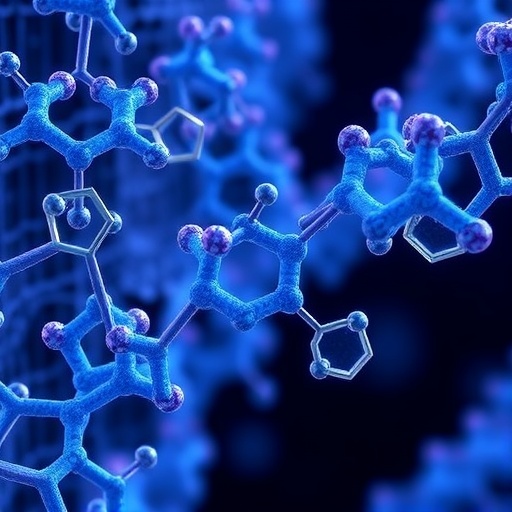
In the dynamic landscape of cancer research, the quest for innovative treatment avenues remains paramount, particularly in the context of triple negative breast cancer (TNBC), which poses significant therapeutic challenges due to its aggressive nature and lack of targeted therapies. Recent investigations have illuminated the potential therapeutic properties of Polygonum multiflorum, a traditional herbal remedy, specifically focusing on its active compound, trans-2,3,5,4ʹ-tetrahydroxystilbene 2-O-β-D-glucopyranoside (TSG). This study marks a pivotal moment in understanding how TSG can induce ferroptosis, a form of regulated cell death characterized by the accumulation of lipid peroxides, presenting a promising frontier in the fight against TNBC.
Ferroptosis diverges from traditional apoptosis and necrosis, presenting unique characteristics that make it an attractive target in cancer therapy. The induction of ferroptosis in TNBC cells via TSG hinges upon its ability to trigger oxidative stress, leading to lipid peroxidation and consequent cell death. Exploration of this mechanism revealed that treatment with TSG significantly elevates levels of reactive oxygen species (ROS) and lipid peroxides, such as 4-hydroxynonenal (4-HNE), which are influential in executing ferroptosis. This finding not only underscores the efficacy of TSG but also positions ferroptosis as a developer’s target for therapeutic intervention.
The study meticulously documented both in vivo and in vitro experiments that corroborate the findings surrounding TSG’s role. Tumor models demonstrated a substantial reduction in proliferation and metastatic potential of TNBC cells post-treatment with TSG. These experiments build credibility around TSG’s application as a potential agent that can be utilized in clinical settings, targeting the specific needs of TNBC patients. By effectively restraining the growth and invasive characteristics of these cancer cells, TSG offers a dual-pronged approach, attacking both the proliferation and spread of cancer.
Furthermore, the investigative team did not stop at TSG; they expanded their horizons to explore other stilbene glycoside oligomers derived from Polygonum multiflorum. This diversified study revealed similar cytotoxic effects on TNBC cell lines, enhancing the biological relevance and therapeutic potential of this plant. The ability of these compounds to induce ferroptosis opens doors to a broader portfolio of therapeutic possibilities, especially for patients who have limited options.
In the broader context of oncological research, the implications of integrating herbal medicine such as Polygonum multiflorum into contemporary treatment paradigms pose intriguing questions. As the efficacy and safety of these compounds are further substantiated, we might witness a shift towards more holistic approaches in cancer care. The indigenous knowledge surrounding traditional herbs, combined with modern scientific techniques, can pave the way for novel, less toxic treatment modalities.
As researchers continue to delve into the complexities of ferroptosis, it is crucial to elucidate the pathways through which TSG and other compounds exert their effects. Understanding the signaling mechanisms involved in ferroptosis can inform future research and therapeutic design, ultimately enhancing the effectiveness of treatments for TNBC. By manipulating the ferroptotic pathway, researchers may develop strategies that complement existing therapies, create new combinations, and potentially increase patient survival rates.
The growing body of evidence supporting ferroptosis as an effective therapeutic strategy emphasizes the shift in also recognizing the metabolic vulnerabilities of cancer cells. The reliance on oxidative stress as a mechanism to induce cell death in TNBC aligns with observations that many cancer cells exhibit adaptive responses to oxidative damage. Creating strategies that consistently harness this vulnerability could significantly advance treatment options for patients facing aggressive cancer types.
The implications extend beyond clinical applications; they also encompass the critical intersection of pharmacognosy and biotechnology. The mechanisms by which natural compounds like TSG resonate with cellular pathways necessitate an ongoing dialogue between traditional knowledge and modern scientific inquiry. Such interdisciplinary collaboration could yield breakthroughs, ultimately translating natural products into potent therapeutic agents.
In conclusion, the findings surrounding Polygonum multiflorum and its active compound TSG serve as a compelling reminder of the untapped potential that nature holds in the realm of cancer therapy. As the study enthusiasts continue to push the boundaries of our understanding, the prospect of integrating such compounds into clinical practices remains tantalizingly close. The ongoing research not only promises to redefine the therapeutic landscape of TNBC but also offers hope for countless patients battling this formidable disease.
Subject of Research: The effects of Polygonum multiflorum Stilbene Glycoside Oligomers on triple negative breast cancer cells.
Article Title: Polygonum multiflorum Stilbene Glycoside Oligomers induce the ferroptosis of triple negative breast cancer cells.
Article References:
Lin, X., Yang, H., Cai, T. et al. Polygonum multiflorum Stilbene Glycoside Oligomers induce the ferroptosis of triple negative breast cancer cells.
BMC Cancer 25, 676 (2025). https://doi.org/10.1186/s12885-025-13999-z
Image Credits: Scienmag.com
DOI: https://doi.org/10.1186/s12885-025-13999-z
Keywords: Triple negative breast cancer, ferroptosis, Polygonum multiflorum, trans-2,3,5,4ʹ-tetrahydroxystilbene 2-O-β-D-glucopyranoside, oxidative stress, lipid peroxides, cancer therapy.
Tags: 34ʹ-tetrahydroxystilbene 2-O-β-D-glucopyranoside5ferroptosis in cancer therapyherbal remedies for cancer treatmentinnovative cancer research approacheslipid peroxidation mechanismsoxidative stress and cancerPolygonum multiflorum medicinal propertiesreactive oxygen species in cancerregulated cell death in oncologytherapeutic strategies for aggressive cancerstrans-2triple negative breast cancer treatmentTSG and ferroptosis induction





